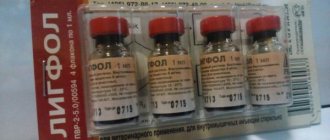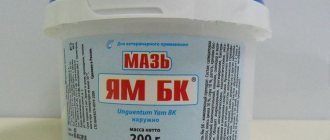Treating cats usually requires special medications designed for animals. They are produced taking into account the metabolic characteristics of representatives of the cat family, which allows you to extract maximum benefit from the medicinal substance and avoid unwanted effects. However, there are a number of products that are suitable for both people and cats. They are sold in regular pharmacies without a prescription.
One of these drugs is Metronidazole and its analogues based on the active substance of the same name (for example, Trichopolum). What diseases in cats can be treated with metronidazole? How to correctly calculate the required dose? What is the most convenient method of administration?
Chemical composition of the drug
The active substance of the drug is a synthetic derivative of azomycin, which in nature is produced by a special genus of bacteria - streptomycetes. Metronidazole demonstrates the greatest activity against anaerobic bacteria and protozoa (amoebas, histomonads, trichomonas, etc.).
There are 5 forms of the drug on sale:
How metronidazole works
Metronidazole is an antibiotic.
The main task of drugs in this group is to destroy pathogenic bacteria (and sometimes protozoa) found in the body of a sick person or animal. Metronidazole is most active against protozoal and anaerobic microorganisms. Its target is bacterial DNA, the defeat of which leads to the death of pathogenic microbes. Metronidazole has a bactericidal effect: unlike bacteriostatic drugs, it does not block the process of bacterial reproduction, but kills them.
Types of microorganisms sensitive to metronidazole:
- protozoa (Giardia, Entamoeba, Trichomonas, Balantidium);
- anaerobic bacteria.
Since the antibacterial effect applies only to anaerobes, the drug is often prescribed together with other antibiotics, such as penicillins, cephalosporins and aminoglycosides. In addition to the main antibacterial effect, metronidazole has a mild immunomodulatory effect.
Methods of drug administration:
- oral (tablets, suspensions);
- parenteral (intravenous injections);
- external (ointments, gels);
- rectal (in the form of enemas).
- Cimitidine
- Cyclosporine
- Warfarin
- 5-fluorouracil
- Phenytoin
- Phenobarbital
What medicines contain metronidazole: list, cost, use
Metronidazole is available in several forms:
- tablets of 500 and 250 mg (a package containing 20 tablets costs from 15 to 100 rubles);
- suspension containing 200 mg/5 ml (price per 100 ml bottle - from 200 rubles);
- sterile solution for intravenous injection 5 mg/ml (100 ml bottle costs 27 rubles);
- 1 percent gel and ointment for external use (30 g - from 190 rubles);
- dental gel 1 percent (price of a tube of 20 g - 258 rubles).
Other release options (vaginal cream and suppositories) are usually not used in veterinary medicine. Oral and parenteral forms are prescribed according to indications. Metronidazole should not be used to treat pregnant or nursing cats. If it is necessary to give the drug to a nursing cat, then the kittens are transferred to artificial feeding until the end of treatment. For kittens under 6 months of age, the medicine is prescribed only in extreme cases.
Metronidazole for cats: description, what it is needed for
The second name of the drug is Trichopolum, since the drug is intended to destroy the causative agents of sexually transmitted infections Trichomonas. Also effective against Amoebas, Histomonas, Balantidia, Giardia. Metronidazole is effective in situations in which antibiotics are powerless.
The drug is recommended for the treatment of protozoal diarrhea, skin diseases, and oral cavity. Of the variety of dosage forms, only 250 mg tablets are suitable for cats, which are freely sold in medical pharmacies.
In certain situations, drugs containing Metronidazole are in demand. It is noteworthy that veterinary pharmacies sell such products only with a prescription from a veterinarian.
The principle of action of the drug
Metronidazole affects the DNA of microorganisms and protozoa, suppressing the production of nucleic acids and causing their death. Once inside the animal’s body, the substance is well absorbed from the gastrointestinal tract and distributed throughout the body’s biological fluids (saliva, bile, cerebrospinal fluid, etc.).
The active substance accumulates in the liver and is excreted after 1-2 days along with waste products.
Medicinal properties of Metronidazole
The drug includes 25% of the active substance. The color of the tablets may be white or with a yellowish/greenish tint. The weight of one tablet is only 0.25 g.
The antibiotic in question is actively used in the treatment of trichomonas, lamblia, amoebae, histomonas, and so on. Veterinarians often use this remedy for tetanus or all kinds of inflammatory processes.
When the medicine is administered orally, the active substance is well absorbed and enters the organs and tissues of the digestive tract. The drug accumulates in the liver.
Metronidazole is excreted from the animal's body along with urine, feces, and also penetrates slightly into milk. Therefore, it is not recommended to use the medication for lactating animals.
The drug has a number of side effects:
- allergy;
- Nausea;
- damage to the central nervous system, which manifests itself in the form of ataxia, seizures, etc.
Side effects
The use of Metronidazole for cats, like any other antimicrobial drug, significantly affects the animal’s immunity, weakening the body’s protective functions. That is why during treatment with the drug it is recommended to isolate the pet from other animals and keep the house completely clean for a certain time. Against the background of a weakened immune system, the pet may develop signs of an allergy that was not previously noticed, which will lead to a deterioration in the animal’s condition.
In addition, the cat may experience nausea, vomiting, diarrhea, constipation, loss of appetite and other gastrointestinal disorders.
Hyperactivity, weakness, frequent urination, drowsiness, dizziness and depression are also observed in animals. As a rule, you can notice such negative reactions at the first manifestations, since the cat’s body is very sensitive.
An extremely rare increase in body temperature is also a side effect of taking the drug. During illness, it is difficult to determine the connection between fever and the prescribed drug on your own, so you need to carefully monitor any changes in your pet’s behavior.
Elimination of all minor reactions is carried out by stopping the medication, but, as a rule, this is not required, since in most cases the correct dosage does not entail any negative consequences.
Side effects
Side effects of Metronidazole:
- The gastrointestinal tract may be affected. Symptoms such as loss or decreased appetite, vomiting, nausea, constipation, and diarrhea will appear. In such cases, it is better to consult a specialist; he will tell you whether to continue treatment with this drug or stop.
- Changes in the nervous system. These are dizziness, depression or hyperactivity, drowsiness, general weakness. Usually cats have pronounced side symptoms. This makes it possible to react in time and consult a doctor.
- If during treatment your cat develops previously unknown problems with urination , it is better to stop treatment immediately and wait for the advice of a veterinarian.
- It would seem that fever during treatment cannot be a side effect. Unfortunately, this is true, and it is impossible to identify this connection on your own.
- If before the cat did not have any allergies , then during treatment the immune system weakens so much that even an allergy can cause enormous harm to your pet’s health. So if you notice nasal congestion, rash and itching, it is better to consult your doctor. Sometimes it is enough to simply stop using metronidazole. It is worth noting that such cases are quite rare, the medicine is well tolerated by animals.
Application and dosage of the drug
For cats of any age, Metronidazole is prescribed for diagnosed diseases such as:
- giardiasis and histomoniasis;
- dysentery, diarrhea (with severe diarrhea);
- anaerobic postoperative infections, including after obstetric procedures;
- ulcerative gingevitis;
- trichomoniasis and balantiosis;
- necrotizing mastitis and necrobacteriosis.
The required amount of medicine is calculated based on the weight of the animal, according to the proportion - 10 mg of the active substance per 1 kg. However, the attending physician can change this treatment regimen based on specific symptoms and the general condition of the patient.
We recommend reading about the use of the antibiotic “Clamoxil” for the comprehensive fight against infections in pets.
Action of the medication
Metronidazole tablets for cats can be purchased from any manufacturer. Changing the pharmaceutical company does not in any way affect the effectiveness of the drug. The medication is available in dosages of 250 or 500 mg. The tablets are always white, flat-cylindrical, round in shape, with a bitter taste.
Metronidazole is classified as a broad-spectrum antimicrobial and antiprotozoal agent. It can be used in the complex treatment of mastitis, gingivitis, postpartum infections, gastrointestinal diseases, dysentery, stomatitis, diarrhea, balantidiasis, necrobacteriosis, giardiasis, infection with amoebas, trichomonas, and so on.
“Metronidazole” for cats, dogs and other domestic animals (even cattle) is an excellent remedy for many diseases; moreover, they become infected with parasites much more often than humans themselves.
Purpose
The antibiotic Metronidazole is used in the complex treatment of many diseases, including:
- giardiasis;
- mastitis;
- postoperative and postpartum infections;
- pathologies of the digestive system;
- dysentery;
- stomatitis;
- ulcerative gingivitis and others.
Giardiasis in pets is caused by protozoan microorganisms that parasitize the intestines, releasing toxic substances. This leads to a sharp deterioration in metabolic processes in the animal’s body and serious pathologies. One of the most dangerous is prolonged diarrhea, which can lead to general dehydration of the body. With giardiasis, a cat can develop severe allergic reactions, which are very difficult to cure.
The pathology is manifested by the following symptoms:
- cough;
- diarrhea;
- vomit;
- dry skin;
- dullness of coat;
- allergic dermatitis.
Pathology can affect various organs. Thus, against the background of infection, the ducts of the gallbladder can become clogged, which leads to inflammatory liver diseases and pancreatitis.
Amebiasis (amebic dysentery) is caused by the amoeba Entamoeba histolytica. Prolonged diarrhea is caused by inflammation of the colon. A cat can become infected with parasites through food and water. The danger of the disease lies in the fact that it can be asymptomatic, and sometimes rapidly, when the protozoa invade the intestinal mucosa, causing inflammation and bleeding. The disease can be fatal as persistent diarrhea causes dangerous dehydration.
Sometimes amebiasis goes into a chronic stage, then the cat may lose appetite, noticeably lose weight, and have problems with defecation. Treatment of the disease involves the mandatory use of antibiotics. Among other drugs, Metronidazole is the most effective.
Gingivitis and stomatitis are chronic diseases of the oral cavity. Gingivitis is inflammation of the gums; with stomatitis, the mucous membranes of the oral cavity are inflamed. The causes of inflammatory processes have not been fully studied; it has been suggested that they are:
- hypersensitivity to bacterial plaque on teeth and gums;
- disturbances in the functioning of the immune system;
- FLV viruses (feline leukemia), herpes, caliciviruses, feline immunodeficiency.
In addition, diseases of the oral cavity can be provoked by improper feeding, genetic predisposition, and exposure to stress factors.
What it is?
Giardia is the name given to microorganisms that parasitize the small intestine not only in cats, but also in many other animals. Carriers of these protozoa can be rodents, birds, dogs and even humans.
© shutterstock
With the help of a special suction disk located on the abdomen, Giardia attaches to the intestinal mucosa and multiplies, feeding heavily on the digested food of the host. Traveling through the intestines in two forms - trophozoid (a form of Giardia that is capable of reproduction) and a cyst (a stable form with a shell, like the “pupa” of butterflies), the parasites can live in the cat’s body, as well as in soil and water, for many months.
These Giardia are very tenacious: they do not die during the day under the influence of UV rays, and they are not damaged by disinfection of the room with chlorine. Only a decrease in humidity can destroy these creatures. They leave the cat's body along with feces, which is extremely dangerous, since the owner often becomes infected with giardiasis.
Owner reviews
Alina, owner of a 16-year-old cat:
“Due to severe inflammation and abscesses on the cat’s gums, the cat refused food and water. At first they tried to solve the problem on their own and bought Metrogil-dent, but applying it turned out to be an impossible task. Then we went to the doctor, he prescribed Metronidazole. We took the pills for 5 days, the cat returned to his usual lifestyle, the inflammation completely disappeared. Although it’s cheap, it’s effective.”
Nastya, volunteer:
“Once upon a time a grown-up kitten came to my care. A few days later he began to have digestive problems and frequent diarrhea, especially in the morning. I assumed that the problem was due to a change in food, but went to the clinic. The doctor discovered mild dysentery and prescribed a set of medications, including Metronidazole. After just 2 days, the diarrhea completely disappeared, and the functioning of the food system was restored. There were no side effects."
Reviews
Veterinarians have long been using in their practice not only specialized drugs for animals, but also medicines from regular pharmacies. As for the treatment of dogs, it is much easier to find a suitable drug, but when treating giardiasis in cats, veterinarians trust only Metronidazole. It so happens that nothing more effective has yet been invented. As for the treatment of animals that have contraindications for health reasons, despite all the advantages of the medication in question, replacing it is simply necessary for the health and life of the animal. The instructions for Metronidazole (the dosage is prescribed for cats by a veterinarian) provide for treatment at any stage of parasite infection and guarantee results. Veterinarians speak extremely positively about the drug, since it demonstrates the best performance indicators and, with the correct dosage, is in most cases well tolerated by pets. Experts assure that in order to consolidate the results of treatment, it is necessary not only to complete the entire course, but also to provide the pet with adequate nutrition in the future, which will be enough for prevention.
Owners of cats say that in rare cases, the animal’s body may react negatively to the medication.
Analogues of the drug
Metronidazole is the main or constituent part of many medications. Complete analogues containing the same active substance as the claimed drug are:
- trichopolum;
- metrogil;
- flagyl.
Drugs based on ornidazole and tinidazole have a similar effect, however, all drug changes must be agreed with your doctor.
Did you know? Initially, the substance was considered only a remedy for trichomoniasis and was used as an antiprotozoal medicine. The antibacterial effect was discovered by chance when the patient was simultaneously cured of bacterial gingivitis.
Possible limitations and adverse reactions
Metronidazole is contraindicated for four-legged pets if they have liver pathologies and hypersensitivity to the components of the antibiotic. Pregnant and lactating females should not use the antibacterial drug. With the correct dosage and following the veterinarian's recommendations, Metronidazole is well tolerated. But occasionally, during antibiotic therapy, a cat may develop the following adverse events that require discontinuation of treatment:
- allergic reaction;
- nausea;
- involuntary muscle contractions;
- profound disturbance of sensitivity.
Return to contents
"Metronidazole" for cats: purpose, dosage, instructions for use and reviews from veterinarians
As a rule, different specialized drugs are used to treat people and animals, but some medications can be considered universal. One of these drugs is the antibiotic Metronidazole, originally intended for the treatment of humans, but today it is widely used in veterinary medicine.
It is prohibited to use it independently on animals, and only an experienced specialist can prescribe the drug, taking into account the diagnosis and weight of the pet to calculate the correct dosage.
Dosage
On average, the active component of the drug is 10 mg per 1 kg of cat weight. The dosage of Metronidazole for each specific case is calculated individually depending on the severity of the disease and the exact weight of the pet. For some individuals, for a complete and rapid recovery, it is enough to give only 8 mg/kg.
The frequency of administration is always 2 times a day with an interval of 12 hours. It is recommended to choose morning and evening times for this. Relief from the condition of a sick pet occurs after the first dose, since the concentration of the active substance remains at 80% for 8 hours after administration.
Advice from experienced veterinarians
To effectively use the drug and treat diseases in cats, experienced specialists recommend:
- strictly follow the prescribed dosage and do not reduce the number of days of use even if the symptoms of the disease completely disappear;
- It is optimal to give the medicine in the morning and evening;
- when using the drug, it is necessary to avoid contact with mucous membranes; you should wash your hands before and after the procedure;
- since the medicine has the property of reducing the body’s immune response, the animal should be placed in quarantine mode, minimizing the likelihood of infection with other diseases;
- Most likely, you will need to put your cat on a special diet, possibly medicated food.
Metronidazole is an effective drug for the treatment of cats, the use of which is allowed only after diagnosis and receipt of a prescription from a veterinarian.
Metronidazole: instructions for use for animals
The instructions recommend using the drug for the treatment of Trichomonosis in cattle, dysentery, balantidiasis in pigs, and histomoniasis in poultry.
In medicine, Trichopolum is used to treat giardiasis. Gels and creams have been developed for the treatment of skin diseases, as well as dental products for medical and veterinary purposes, which contain Metronidazole.
The instructions for the medication should not be used: the dosage for humans is several times higher than the experimentally established maximum dose for cats.
But, even with the correct dosage, side effects may occur in the following cases:
- liver diseases;
- allergy to the active substance or auxiliary components;
- pregnancy and lactation: the drug has an immunosuppressive effect, which makes the kitten defenseless against pathogens of infectious diseases.
Be sure to read:
Amoxisan for cats: instructions, dosage, how to inject, reviews and price
Contraindications
Despite the popularity and widespread use of this drug, there are certain contraindications for its use in animals:
- Having a cat with allergies is a serious reason to refuse medication. Naturally, it is advisable to discuss this issue with a veterinarian. If the situation worsens, the use of corticosteroids may be necessary. Such parallel treatment may worsen the animal’s condition.
- Liver failure.
- During lactation, most of the components end up in the cat's milk, which loses its taste, becoming bitter, and also negatively affects the health of the kittens. They may develop gastrointestinal diseases and allergies. Deaths are quite rare. It is necessary to isolate kittens in a timely manner and implement artificial nutrition. Only on the third day after taking Metronidazole can you resume breastfeeding; in general, this is quite difficult to do and the kittens will have to be fed independently until they learn to eat on their own.
- Taking Metronidazole during pregnancy affects the condition of the cat, as well as unborn kittens. At present, the effect of the drug during pregnancy has not been fully studied, but there have been cases where the cat’s health deteriorated significantly.
Contraindications and side effects
The instructions for use contain contraindications for Metronidazole, which also apply to cats. Stop using the drug in the following cases:
- For liver failure.
Since the drug is metabolized in the liver, the load on the organ increases, which can cause complications. In addition, the body will not be able to cope with the removal of the medication from the body. - In case of intolerance to components.
In this case, allergic reactions occur. They can be mild or cause anaphylactic shock. - During pregnancy.
There have been no formal studies of the drug in this group of animals, but it is believed that it may have an effect on the development of offspring. - During lactation.
The components of the drug easily penetrate into the body of the offspring through mother's milk. The drug can suppress the kitten's immune system, which can cause life-threatening infections.
Metronidazole rarely causes side effects in animals. In addition to allergic reactions, other health problems are sometimes observed:
- disorders of the digestive system;
- depression;
- lack of appetite;
- irritability, etc.
Side effects may increase when the dose is exceeded. In case of allergic reactions, the animal should be given an anti-allergenic agent. Additionally, symptomatic therapy can be used.
Important! Metronidazole has the ability to suppress the immune system, so during treatment it is necessary to reduce the likelihood of contracting infections. It is advisable to isolate the pet from other animals and limit its stay on the street.
Smecta
A well-known medical remedy that perfectly helps not only with diarrhea, but also with heartburn and other problems with the digestive system. It has a neutral taste and can be used in veterinary medicine. For a cat weighing up to 2.5 kg inclusive, take one sachet of medicine. Its contents are diluted in a small volume of warm boiled water, after which it is drunk in the same way as discussed in the part devoted to activated carbon.
Are there any contraindications and points that both owners and veterinarians need to remember? As for the “purebred” Smecta, there are no contraindications. But if you use various “Smectins”, be sure to read the composition and instructions. If there are at least some salicidates, giving such a drug to a cat is strictly prohibited. Salicylic acid salts are a strong poison for all cats!
How to store Metronidazole at home
We have already noted that the medicine is available in packs of 250 pieces. There is also a form in the form of a yellowish or white powder, which is packaged from 100 g to a kilogram.
It is recommended to store Metronidazole in a dark place where it is dry and none of the children can get to the drug. Also make sure that animals do not have access to this area.
Do not store the medicine near food and feed. The optimal temperature is from -10 to +40 degrees. Under such conditions, the medicine can be stored for up to two years.
Metronidazole is used not only for cats, but also for other animals. Therefore, after using the medicine, it is not recommended to eat meat or milk from animals that were treated. Animals can be slaughtered a week after the course of treatment with the drug.
To summarize the article, we note that now you know how to give your cat Metronidazole to treat certain diseases. The medicine is most often used to treat diarrhea in pets.
When treating more complex pathologies, be sure to consult a veterinarian who will prescribe the appropriate course. Do not self-medicate.
The drug in question is an antibiotic, and serious consequences are possible due to the incorrect use of Metronidazole.
Liquid stools of varying consistency, with admixtures of mucus and blood, lack of appetite, weakness and other painful symptoms indicate pathological processes in the organs of the digestive tract. To diagnose the problem and treat it, you need to consult a doctor. However, how to treat diarrhea in cats when it is not possible to immediately contact a veterinarian? In this case, antimicrobial drugs, sorbents, enzymes, and probiotics will help to eliminate the cause of the pathology and restore the functioning of the digestive tract.
When to use
According to the instructions, Metronidazole is prescribed for cats with various pathologies:
- with balanthiosis;
- with gingivitis;
- with aphthous stomatitis;
- with disentery;
- with trichomoniasis;
- with giardiasis;
- with necrobacteriosis;
- with necrotic mastitis;
- for infections after childbirth;
- for other diseases caused by bacteria that are sensitive to the drug.
Metronidazole can also be given to cats for diarrhea resulting from food poisoning. In any case, the drug should be used only after examining the animal and establishing an accurate diagnosis.
Indications
According to veterinary expert I.V. Golubova, the antibacterial drug Metronidazole cures such pathological conditions as:
- postpartum infections;
- dysentery;
- dermatological pathologies;
- prolonged diarrhea;
- inflammatory process on the gums;
- diseases of the mammary glands;
- damage to the mucous layer of the oral cavity;
- pathologies of the food tube.
If the animal’s cough is severe, then the drug can become part of complex therapy.
In addition, Metronidazole is also prescribed to cats for trichomoniasis, edema, and infectious damage to the nervous system caused by bacteroids. You can give an antibiotic to kittens whose diagnostic tests revealed an anaerobic bacterial infection, acute amebiasis, endometritis, or bacterial septicemia. They treat severe coughs, but in combination with other medications, for example, together with the expectorant Ambroxol. It is clear from the prescriptions that the scope of Metronidazole is quite wide, so it is extremely important to diagnose the cat in order to accurately establish the diagnosis and prescribe dosages in accordance with it.
Recommendations from experts
To avoid serious health problems for your pet, you should regularly prevent parasite infestation. Cats, especially those that go outside, are prone to developing enterobiasis, head lice, fleas and other pests.
Metronidazole may not always help cats, so at the first symptoms of infection, you should contact a veterinarian for appropriate help.
If your pet has diarrhea and is unable to visit a doctor, you can give the drug to your pet yourself, but only after correctly calculating the dose. Even if the symptoms stop after this, you still need to seek advice from a specialist.
Metronidazole for cats: dosage
The standard single dose is considered to be 10 mg/kg body weight. The most convenient form of Metronidazole for cats is a tablet containing 250 mg. In this case, a cat weighing 4 kg should be given 1/6 of the tablet. After 12 hours, the medication should be repeated. Cats do not like the bitter taste of the antiprotozoal drug, so the owner needs to contrive to get the pet to swallow the medicine.
The usual technique does not work on the root of the tongue. Reflex salivation occurs. And the cat felt bad, and the medicine did not reach the stomach. Therefore, a carefully measured dose is ground into powder, a solution is made and poured into the mouth. After this, they give a portion of plain water and a treat.
An alternative option is to hide the medicine inside tasty food. In order to protect itself from claws and teeth, the pet is secured in a towel.
The standard course of treatment is 5-7 days. Veterinarians are reluctant to extend the use of Metronidazole, since there are no official instructions for use of the drug in cats.
However, ointment or cream containing Metronidazole and used in the treatment of skin diseases are popular. An antiprotozoal antibiotic is included in the veterinary dental gels Zubastik and Dentavedin. The drug is used to treat stomatitis and gingivitis.











